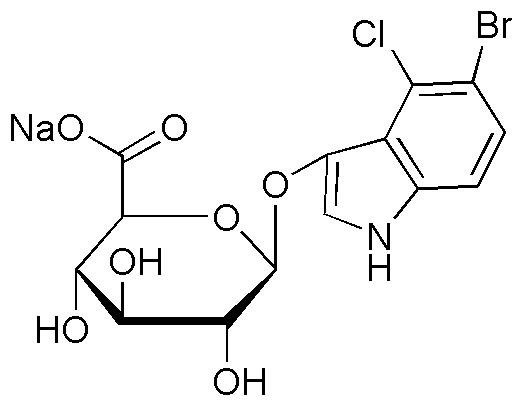5-Bromo-4-chloro-3-indolyl-b-D-glucuronide sodium salt is widely utilized in research focused on:
- Histochemical Staining: This compound is commonly used as a substrate in histochemical assays to visualize β-glucuronidase activity in tissue samples, aiding researchers in studying enzyme localization and activity.
- Drug Metabolism Studies: It serves as a model substrate for investigating the metabolism of glucuronidated drugs, helping pharmaceutical researchers understand drug interactions and clearance rates.
- Cellular Assays: This chemical is employed in cellular assays to monitor cellular processes, such as apoptosis and proliferation, providing valuable insights into cell behavior in response to various treatments.
- Biochemical Research: It is used in biochemical studies to explore the role of glucuronidation in detoxification pathways, enhancing our understanding of metabolic processes in different organisms.
- Environmental Monitoring: The compound can be utilized in environmental studies to assess the impact of pollutants that undergo glucuronidation, contributing to ecological research and sustainability efforts.
General Information
Properties
Safety and Regulations
Applications
5-Bromo-4-chloro-3-indolyl-b-D-glucuronide sodium salt is widely utilized in research focused on:
- Histochemical Staining: This compound is commonly used as a substrate in histochemical assays to visualize β-glucuronidase activity in tissue samples, aiding researchers in studying enzyme localization and activity.
- Drug Metabolism Studies: It serves as a model substrate for investigating the metabolism of glucuronidated drugs, helping pharmaceutical researchers understand drug interactions and clearance rates.
- Cellular Assays: This chemical is employed in cellular assays to monitor cellular processes, such as apoptosis and proliferation, providing valuable insights into cell behavior in response to various treatments.
- Biochemical Research: It is used in biochemical studies to explore the role of glucuronidation in detoxification pathways, enhancing our understanding of metabolic processes in different organisms.
- Environmental Monitoring: The compound can be utilized in environmental studies to assess the impact of pollutants that undergo glucuronidation, contributing to ecological research and sustainability efforts.
Documents
Safety Data Sheets (SDS)
The SDS provides comprehensive safety information on handling, storage, and disposal of the product.
Product Specification (PS)
The PS provides a comprehensive breakdown of the product’s properties, including chemical composition, physical state, purity, and storage requirements. It also details acceptable quality ranges and the product's intended applications.
Certificates of Analysis (COA)
Search for Certificates of Analysis (COA) by entering the products Lot Number. Lot and Batch Numbers can be found on a product’s label following the words ‘Lot’ or ‘Batch’.
*Catalog Number
*Lot Number
Certificates Of Origin (COO)
This COO confirms the country where the product was manufactured, and also details the materials and components used in it and whether it is derived from natural, synthetic, or other specific sources. This certificate may be required for customs, trade, and regulatory compliance.
*Catalog Number
*Lot Number
Safety Data Sheets (SDS)
The SDS provides comprehensive safety information on handling, storage, and disposal of the product.
DownloadProduct Specification (PS)
The PS provides a comprehensive breakdown of the product’s properties, including chemical composition, physical state, purity, and storage requirements. It also details acceptable quality ranges and the product's intended applications.
DownloadCertificates of Analysis (COA)
Search for Certificates of Analysis (COA) by entering the products Lot Number. Lot and Batch Numbers can be found on a product’s label following the words ‘Lot’ or ‘Batch’.
*Catalog Number
*Lot Number
Certificates Of Origin (COO)
This COO confirms the country where the product was manufactured, and also details the materials and components used in it and whether it is derived from natural, synthetic, or other specific sources. This certificate may be required for customs, trade, and regulatory compliance.


